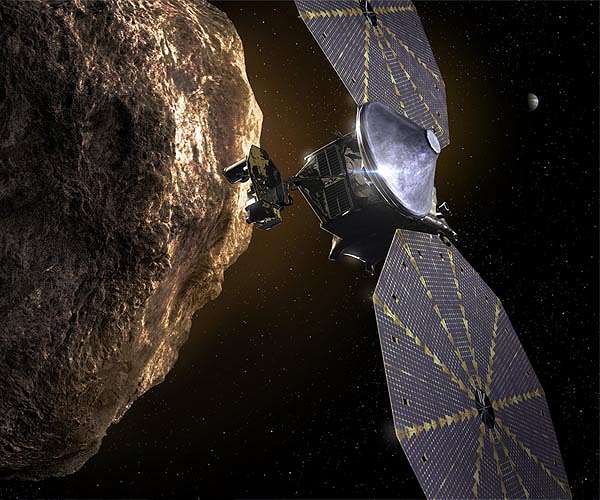
NASA’s Lucy Mission Suspending Further Solar Array Deployment Activities (Image Credit: Space Daily)
NASA’s Lucy mission team has decided to suspend further solar array deployment activities. The team determined that operating the mission with the solar array in the current unlatched state carries an acceptable level of risk and further deployment activities are unlikely to be beneficial at this time. The spacecraft continues to make progress along its planned trajectory.
Shortly after the spacecraft’s Oct. 2021 launch, the mission team realized that one of Lucy’s two solar arrays had not properly unfurled and latched. A series of activities in 2022 succeeded in further deploying the array, placing it into a tensioned, but unlatched, state. Using engineering models calibrated by spacecraft data, the team estimates that the solar array is over 98% deployed, and it is strong enough to withstand the stresses of Lucy’s 12-year mission.
The team’s confidence in the stability of the solar array was affirmed by its behavior during the close flyby of the Earth on Oct. 16, 2022, when the spacecraft flew within 243 miles (392 km) of the Earth, through the Earth’s upper atmosphere. The solar array is producing the expected level of power at the present solar range and is expected to have enough capability to perform the baseline mission with margin.
The team elected to suspend deployment attempts after the attempt on Dec. 13, 2022, produced only small movement in the solar array. Ground-based testing indicated that the deployment attempts were most productive while the spacecraft was warmer, closer to the Sun.
As the spacecraft is currently 123 million miles (197 million km) from the Sun (1.3 times farther from the Sun than the Earth) and moving away at 20,000 mph (35,000 km/hr), the team does not expect further deployment attempts to be beneficial under present conditions.
Due to the energy boost that the spacecraft received during last October’s Earth gravity assist, the spacecraft is now on an orbit which will take it over 315 million miles (500 million km) from the Sun before returning to Earth for a second Earth gravity assist on Dec. 12, 2024.
Over the next year and a half, the team will continue to collect data on how the solar array behaves during flight. Most significantly, the team will observe how the array behaves during a maneuver in Feb. 2024, when the spacecraft operates its main engine for the first time. As the spacecraft warms up during its approach to Earth in the fall of 2024, the team will re-evaluate if additional steps to reduce risk will be needed.
Related Links
Lucy at NASA Blogs
Lucy at SwRI
Asteroid and Comet Mission News, Science and Technology
|
|
Tweet |
|
|
|
We need your help. The SpaceDaily news network continues to grow but revenues have never been harder to maintain. With the rise of Ad Blockers, and Facebook – our traditional revenue sources via quality network advertising continues to decline. And unlike so many other news sites, we don’t have a paywall – with those annoying usernames and passwords. Our news coverage takes time and effort to publish 365 days a year. If you find our news sites informative and useful then please consider becoming a regular supporter or for now make a one off contribution. |
||
|
SpaceDaily Monthly Supporter $5+ Billed Monthly |
SpaceDaily Contributor $5 Billed Once credit card or paypal |
|
New explanation for Jupiter’s two massive asteroid swarms
Abu Dhabi UAE (SPX) Jan 18, 2023
An international team of scientists including NYUAD researcher Nikolaos Georgakarakos and others from the US, Japan, and China led by Jian Li from Nanjing University, has developed new insights that may explain the numerical asymmetry of the L4 and L5 Jupiter Trojan swarms, two clusters containing more than 10,000 asteroids that move along Jupiter’s orbital path around the sun.
For decades, scientists have known that there are significantly more asteroids in the L4 swarm than the L5 swarm, but hav … read more









